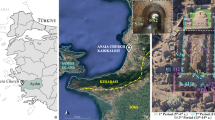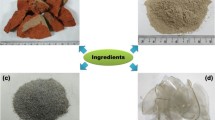Abstract
The galeb of Kebili is a sun-dried brick belonging to the construction tradition of the homonymous “oasis city” of southern Tunisia, obtained by mixing water, fired gypsum-rich Sahara sand and palm wood ash. In recent years, great efforts have been made to enhance the features of these construction materials while preserving the traditional production techniques. In order to evaluate possible improvements in the brick’s physical and mechanical properties, both different firing techniques of raw materials and various ash content in the composition, have been considered. Experimental results showed that modifying the traditional method of combustion by firing the sand at a controlled temperature (160 °C) in a standard oven, allows to obtain a galeb brick with improved mechanical and physical properties. Moreover, keeping the traditional method of combustion, mechanical and physical properties may be optimized by adding a controlled amount of raw ash (about 5 %) in the galeb bricks composition.








Similar content being viewed by others
Notes
The main mineralogical component is CaSO4·2H2O (calcium sulphate dihydrated).
In 2004, an integrated program aiming to valorize Sahara and Southern Tunisia regions, titled “Study, preservation and valorization of Tunisian Oasis Cities”, has been promoted by the Architecture Faculty of Mediterranea University of Reggio Calabria and the Architecture School of the University of Carthage (Tunisia), and supported by the Italian Ministery of Foreign Affairs.
At T > 250 °C the soluble phase of calcium sulphate anhydrous (CaSO4-α) is transformed into an insoluble phase (CaSO4-β), much less reactive with water.
References
Asprone D, Cadoni E, Iucolano F, Prota A (2014) Analysis of the strain-rate behavior of a basalt fiber reinforced natural hydraulic mortar. Cement Concr Compos 53:52–58
ASTM C618 (2012) Standard specification for coal fly ash and raw or calcined natural pozzolan for use in concrete, ASTM International, West Conshohocken
Ben Ali F (2011) Local materials in the oasis cities of South Tunisia: a path of innovation. In: Germanà ML (ed) Mediterranean architecture between heritage and innovation. Firenze University Press, Firenze, pp 295–300
Ben Ali F (2012) The vernacular architecture of the Tunisian oasis-cities: element of specific cultural landscape. In: De Joanna P, Francese D, Passaro A (eds) Sustainable environment in the Mediterranean region: from housing to urban and land scale construction. FrancoAngeli, Milano, pp 72–80
Ben Ali F, Iucolano F, Piscopo D, Fumo M, Caputo D (2012) The galeb of Southern Tunisia: from tradition to innovation. In: De Joanna P, Francese D, Passaro A (eds) Sustainable environment in the Mediterranean region: from housing to urban and land scale construction. FrancoAngeli, Milano, pp 141–148
Biscontin G, Pellizon Birelli M, Zendri E (2002) Characterization of binders employed in the manufacture of Venetian historical mortars. J Cult Herit 3:31–37
Elsen J (2006) Microscopy of historic mortars—a review. Cem Concr Res 36:1416–1424
EN 1015–11 (2006) Methods of test for mortar for masonry—part 11: determination of flexural and compressive strength of hardened mortar. European Committee for Standardization, Brussels
EN 1936 (2006) Natural stone test methods—determination of real density and apparent density, and of total and open porosity. European Committee for Standardization, Brussels
Fassina V, Favaro M, Naccari A, Pigo M (2002) Evaluation of compatibility and durability of a hydraulic lime-based plaster applied on brick wall masonry of historical buildings affected by rising damp phenomena. J Cult Herit 3:45–51
Iucolano F, Liguori B, Caputo D, Colangelo F, Cioffi R (2013) Recycled plastic aggregate in mortars composition: effect on physical and mechanical properties. Mater Des 52:916–922
Iucolano F, Liguori B, Colella C (2013) Fibre-reinforced lime-based mortars: a possible resource for ancient masonry restoration. Constr Build Mater 38:785–789
Karni J, Karni E (1995) Gypsum in construction: origin and properties. Mater Struct 28:92–100
Kingery D, Vandiver PB, Prickett M (1998) The beginnings of pyrotechnology part II: the production and use of lime and gypsum plaster in the near east. J Field Archaeol 15(2):219–244
Martinet G, Deloye FX, Golvin JC (1992) Caractérisation des mortiers pharaoniques du temple d’Amon à Karnak. Bulletin de Liaison des Laboratoires des Ponts et Chaussées 181:39–45
Mellaart J (1967) Çatal-Hüyük: a neolithic town in Anatolia. Thames & Hudson, London. McGraw Hill Book Company, New York
Moropoulou A, Bakolas A, Bisbikou K (2000) Investigation of the technology of historic mortars. J Cult Herit 1:45–58
Poon CS, Kou SC, Lam L, Lin ZS (2001) Activation of fly ash/cement systems using calcium sulfate anhydrite (CaSO4). Cem Concr Res 31:873–881
Rollefson G (1990) The uses of plasters at Neolithic ‘Ain Ghazal. Jordan. Archaeomaterials 4:33–54
Watson A (1995) Structure, chemistry and origins of gypsum crusts in southern Tunisia and the central Namibia Desert. Sedimentology 32:855–875
Xu A, Sarkar SL (1991) Microstructural study of gypsum activated fly ash hydration in cement paste. Cem Concr Res 21:1137–1147
Author information
Authors and Affiliations
Corresponding author
Rights and permissions
About this article
Cite this article
Ben Ali, F., Iucolano, F., Liguori, B. et al. Physical and mechanical characterization of sun-dried bricks. A case history: the galeb of Kebili . Mater Struct 49, 159–165 (2016). https://doi.org/10.1617/s11527-014-0483-4
Received:
Accepted:
Published:
Issue Date:
DOI: https://doi.org/10.1617/s11527-014-0483-4




